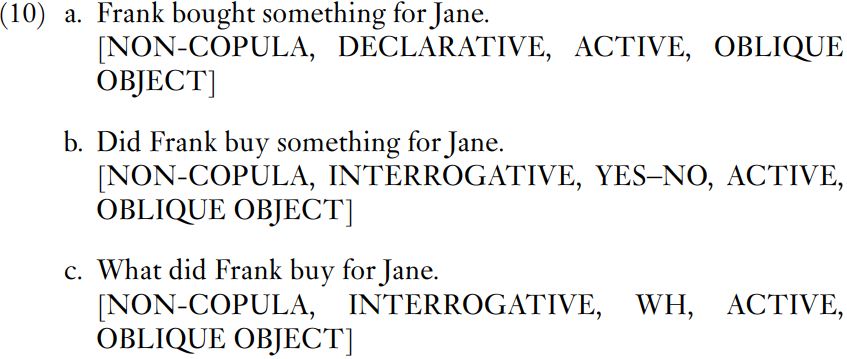


 Grammar
Grammar
 Tenses
Tenses
 Present
Present
 Past
Past
 Future
Future
 Parts Of Speech
Parts Of Speech
 Nouns
Nouns
 Verbs
Verbs
 Adverbs
Adverbs
 Adjectives
Adjectives
 Pronouns
Pronouns
 Pre Position
Pre Position
 Preposition by function
Preposition by function 
 Preposition by construction
Preposition by construction
 Conjunctions
Conjunctions
 Interjections
Interjections
 Grammar Rules
Grammar Rules
 Linguistics
Linguistics
 Semantics
Semantics
 Pragmatics
Pragmatics
 Reading Comprehension
Reading Comprehension|
Read More
Date: 2023-09-01
Date: 2023-06-19
Date: 2023-05-13
|
Two central ideas lie behind the use of the word ‘system’. One is that each of the above constructions shares certain properties with some of the other constructions; the other is that it is possible to specify the relationships between the constructions. The above constructions fall into two major classes, the DECLARATIVE constructions in(7) and the INTERROGATIVE constructions in(8). It is generally accepted that the DECLARATIVE ACTIVE construction in(7a) is basic. It is the most frequent type of construction in English, because speakers most often make assertions, indeed assertions about agents, and it allows the widest range of modifications – for example, Frank had been buying the piano for Jane is perfectly acceptable, and even The piano had been being bought by Frank, though awkward, can be used in texts instead of the unmodified passive, although the texts do not run as smoothly. Examples of the basic construction allow the widest range of adverbs and are semantically basic; the interpretations of Did Frank deceive Emma? and Frank didn’t deceive Emma both involve an understanding of Frank deceived Emma, to which is added an understanding of what is signaled by the interrogative syntax and of what is signaled by the negative didn’t.
The basic construction in (7a) is related to the other constructions in (7b–c) and also to the interrogative constructions in (8). We can think of the relationships among the constructions as paths that lead from the basic construction to the others. Do we lay out paths from the basic construction to every other one, say from the construction in (7a) to the constructions in (7b), (8a) and (8c)? The answer is ‘no’. Instead, we lay out paths from the basic DECLARATIVE construction to the other DECLARATIVE constructions, and then we will put down paths from each of the DECLARATIVE constructions to the corresponding INTERROGATIVE one. Thus a path goes from (7a) to the [DOUBLE OBJECT] construction in (7b) and another path goes from (7b) to the [DOUBLE OBJECT] INTERROGATIVE construction in (8b). Another path goes from the construction in (7a) to the [NONCOPULA, DECLARATIVE, PASSIVE, OBLIQUE OBJECT] construction in (7c). From (7c), a path goes to the [NON-COPULA, INTERROGATIVE, YES–NO, PASSIVE, OBLIQUE OBJECT] construction in (8c). A path goes from (7a) to the construction in (7d), but there is no corresponding [NON-COPULA, INTERROGATIVE, TOPIC] construction for a path to lead to.
What about the constructions in (2)? As explained above, these are WH interrogatives, and a simpler version of (2b) is given in (9).
 In the discussion of (2a–c), we saw that (9) relates not to Frank bought a piano for Jane but to Frank bought something for Jane. The speaker knows that Frank bought and Jane received a present and asks for the present to be specified. We have three constructions to connect, shown in (10).
In the discussion of (2a–c), we saw that (9) relates not to Frank bought a piano for Jane but to Frank bought something for Jane. The speaker knows that Frank bought and Jane received a present and asks for the present to be specified. We have three constructions to connect, shown in (10).

As before, we avoid paths going independently from the construction in (10a) to the constructions in (10b) and (10c). Instead, we will lay down a path from (10a) to (10b) and a path from (10b) to (10c). This captures the fact that (10b) and (10c) have something in common, the occurrence of the auxiliary verb did before the subject Frank. It also captures the fact that in syntactic terms (10c) is further away from (10a) than (10b), since not only is there the auxiliary verb did preceding the subject Frank, but (10c) also contains the WH pronoun what.
|
|
|
|
التوتر والسرطان.. علماء يحذرون من "صلة خطيرة"
|
|
|
|
|
|
|
مرآة السيارة: مدى دقة عكسها للصورة الصحيحة
|
|
|
|
|
|
|
نحو شراكة وطنية متكاملة.. الأمين العام للعتبة الحسينية يبحث مع وكيل وزارة الخارجية آفاق التعاون المؤسسي
|
|
|